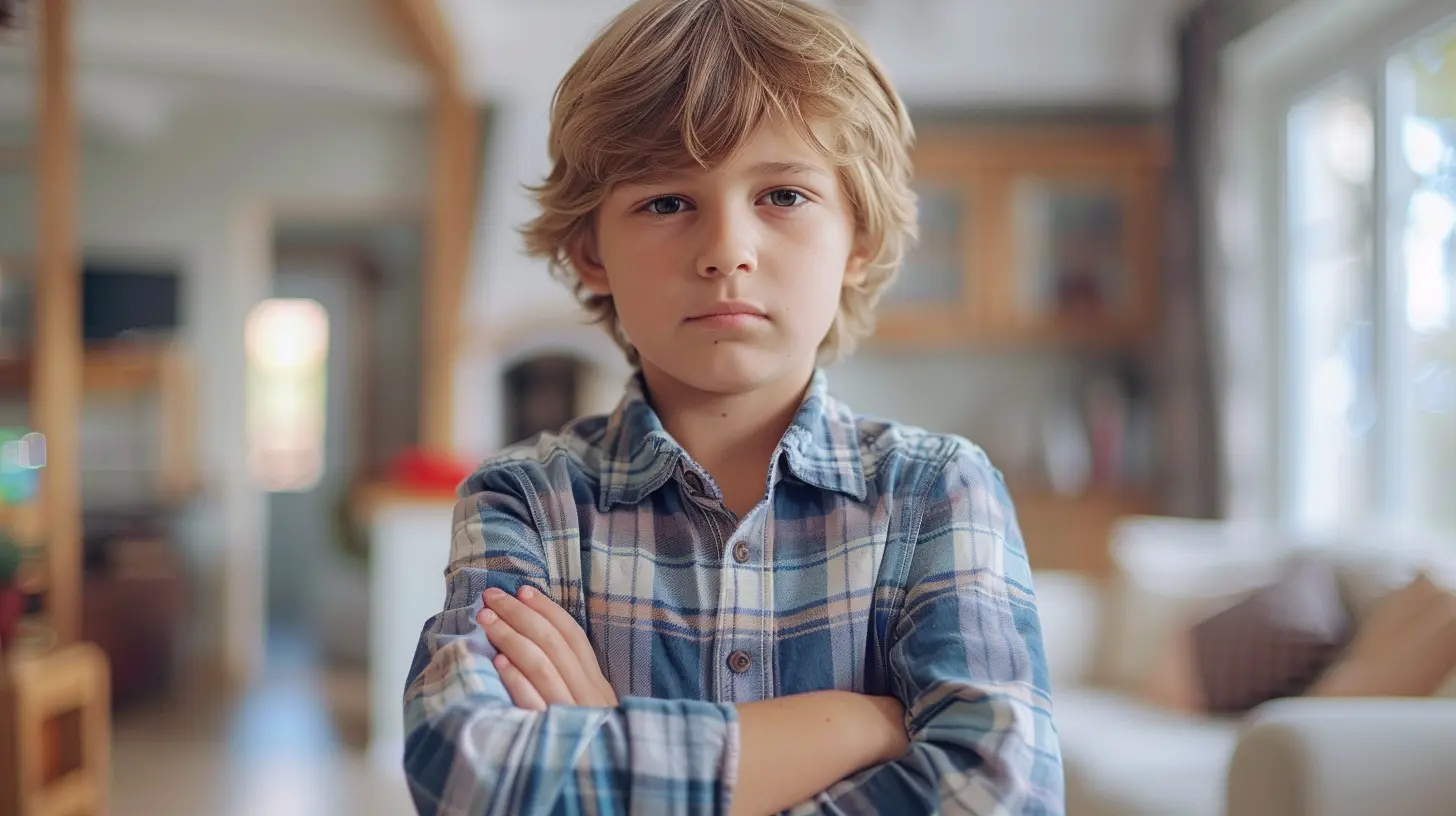How to Teach Kids the Difference Between Rules and Boundaries
19 August 2025
Let’s be honest — parenting is a tightrope walk across Legos, mystery stains, and the emotional rollercoaster that is bedtime. Among the many facepalm-worthy challenges is teaching kids the difference between rules and boundaries.
At first glance, they kinda seem like the same thing, right? One keeps your kid from launching a Hot Wheel at your head, and the other stops you from eating 6 cookies and calling it dinner (okay, maybe that’s just me). But trust me, when it comes to raising responsible, emotionally intelligent little humans, knowing the difference is actually a game changer.
So grab a cup of something caffeinated, sit back, and let’s dig into the surprisingly fascinating—and yes, hilarious—world of rules versus boundaries. 😅
What Even Are Rules and Boundaries?
Rules: The "House Law"
Rules are like the laws of your tiny kingdom (a.k.a. your home). They’re the non-negotiables, the things that keep everyone safe, sane, and (mostly) clean.Think:
- No jumping on the couch (the couch is not a trampoline, Timmy).
- Bedtime is 8PM sharp.
- Finish your broccoli before asking for dessert (we see you, spoon-flipper).
Rules are external expectations. They come from YOU. You enforce them, and kids are expected to follow them. Pretty straightforward.
Boundaries: The "Me-Zones"
Boundaries, on the other hand, are more like personal fences. You're teaching your children that they have limits—and that others do too. Boundaries say:- "It’s okay to say no if someone is making you uncomfortable."
- "You don’t have to hug Grandma if you don’t want to." (Sorry, Grandma.)
- "You can tell your friend you need a break if they’re being too loud."
Boundaries help kids understand where they end and someone else begins. It’s about respect—both for themselves and others. Mind blown yet?
Why It Matters That Kids Know the Difference
Imagine going through life thinking every interaction is a law you have to follow. Exhausting, right?Teaching kids the difference helps them:
- Make better decisions on their own
- Respect others' feelings and space
- Avoid turning into tiny robots or boundary-bulldozers
It's kind of like teaching a kid when to stop at a red light (rule) versus when to say, “Hey, I don’t like getting tickled, stop it!” (boundary). Both involve limits, but the source and purpose are very different.
Kids Are Not Born Knowing This (Shocking, Right?)
Spoiler: Young children are not emotionally equipped to decode social nuances like, “This is a boundary I should respect” or “That’s a rule I have to follow.” I mean, half the time they’re trying to put their shoes on their hands.So, it's up to us, as the snack providers and bedtime enforcers, to teach them.
And no, there’s no one-size-fits-all printable chart (though wouldn’t that be dreamy?).
How to Start Teaching the Difference (Without Losing Your Mind)
1. Make It Relatable
Explain rules as the “family rules” and boundaries as “body or heart rules.”Try this:
- “In our house, we don’t hit. That’s a family rule.”
- “It’s okay to tell your friend you want space. That’s a boundary.”
Kids understand concepts better when they can see them. Try acting out scenarios with stuffed animals (because nothing makes lessons sink in like a bear named Mr. Cuddles refusing a hug politely).
2. Use Real-Life Examples (Like, Daily)
Kids are basically tiny sponge-soakers of chaos and curiosity. Use that.Example:
- “Mommy has a boundary. I need quiet when I’m talking on the phone, so I can hear the other person.”
- “Daddy has a rule about no jumping off the coffee table. It’s to keep you safe.”
Link rules to safety or values. Tie boundaries to respect and feelings.
3. Encourage Boundary-Setting (Even If It Inconveniences You a Bit)
Hard truth: If you want your kid to master respecting others’ boundaries, you’ve got to let them practice their own—even when it messes with your plans.If your toddler says, “I don’t want to be tickled,” pause and back off. Even if you were just about to unleash your world-famous belly zerbert. You’re teaching them self-worth. That’s huge.
Also, how powerful is it to hear your child say, “Please stop, I don’t like that,” instead of just melting into a puddle of silent tears because they didn’t realize they were allowed to speak up?
4. Let Them Experience Consequences (The Natural Kind)
Rules come with consequences. Boundaries too, but they’re different.For example:
- Break the “no throwing food” rule? Clean-up duty for you, tiny tornado.
- Ignore someone’s boundary? That person might not want to play anymore. That’s a natural consequence.
Let consequences be your co-parent. Don’t rush to swoop in immediately with lecture number 47 about kindness. Sometimes a little “real world learning” sticks better.
Tricky Situations (Because Kids Are Professionals at Chaos)
When They Set Ridiculous Boundaries
“My room is a no-pants zone.”“I have a boundary: no chores ever.”
Okay… not quite what we meant.
Here’s the thing — teaching kids about boundaries doesn’t mean you let them run the house like a pajama mafia. You still enforce your rules. So when their “boundary” conflicts with a family rule, it’s time for discussion.
Say:
- “I hear that you want space. That’s totally okay. But part of being in a family is helping out, so let’s talk about when you can do your chore instead of not doing it at all.”
Boom. Respect + reality = parenting win.
When They Start Policing Your Rules
“Mom, you're breaking the rule by eating a cookie before dinner.”Welp. You did say “rules are rules.” Congrats on raising a rule lawyer.
Instead of spiraling into cookie guilt, use it as a teaching moment.
“Well spotted, kiddo! Grown-ups have rules too, like eating healthy. But sometimes we make exceptions. What's important is knowing why the rule exists and using good judgment.”
Then eat the cookie with grace. You've earned it.
Teaching Respect for Other People’s Boundaries
This is where the magic happens.Helping kids recognize when someone else sets a boundary — and accept it without a full-blown meltdown — is a key to future healthy relationships. Teach them phrases:
- “Okay, I’ll give you space.”
- “I won’t touch your toy if you don’t want me to.”
- “That’s your body, and I respect that.”
Say it with them. Practice it. Praise it. Dance it if you must. The more it becomes normal, the more it becomes natural.
The Power of Modeling (AKA Walk the Talk)
Let’s be real: kids are like little detectives with PhDs in spotting hypocrisy.If you yell “USE YOUR WORDS!” while stomping and slamming the fridge shut, your credibility’s toast.
Model the behavior:
- Set your own boundaries calmly (“I need 10 minutes of quiet to reset”)
- Respect theirs (“You don’t want to hug right now? That’s okay.”)
- Follow rules you create (“We clean up our toys after playtime” — yes, you too…)
They’ll mirror what they see faster than they’ll hear your 60th speech about kindness. Trust me.
Age Breakdown: How This Looks at Different Stages
Toddlers (1-3 Years)
- Keep it simple and consistent.- Use short phrases like “No bite. That hurts.”
- Teach boundaries with body parts (“Only you touch your private parts.”)
Preschoolers (3-5 Years)
- Use pretend play to demonstrate empathy.- Introduce phrases like “I don't like that.”
- Praise boundary recognition (“Thanks for using your words!”)
School-Age Kids (6-10 Years)
- Talk openly about feelings and respect.- Encourage personal space and emotional honesty.
- Introduce peer boundary scenarios (“What if your friend doesn’t want to share?”)
Tweens and Teens (11+)
- Get real. Talk relationships, social pressure, digital boundaries.- Empower decision-making.
- Validate their need for autonomy—while still holding firm on household rules.
When You Make Mistakes (Because You Will)
Spoiler alert: You’re not a parenting robot. You’ll mess up. You’ll ignore a boundary or break a rule. What matters is the bounce-back.Apologize. Talk it out. Let your kid see you owning your slip-ups. It teaches humility, responsibility, and that even grown-ups are works in progress.
And hey, nothing bonds a parent and child like mutual awkwardness and emotional honesty, right?
Final Thoughts: Raising Kids Who Get It
Teaching your kids the difference between rules and boundaries isn’t some one-and-done chat. It’s a life skill, like tying shoes or making decent pancakes.But the payoff? Kids who:
- Stand up for themselves
- Respect others
- Know when to say no
- Follow what’s fair
- And question what isn’t
Basically, the kind of adult you’d want to hang out with… or at least, the kind who won’t eat your last cookie without asking.
So keep the convo going. Keep it light, keep it honest, and for heaven’s sake — keep it real. Parenthood isn’t Pinterest: it’s messy, glorious, and full of wild lessons. Just like this one.
all images in this post were generated using AI tools
Category:
Discipline TechniquesAuthor:

Maya Underwood
Discussion
rate this article
1 comments
Elin Taylor
Great tips! Love how clear this is!
September 5, 2025 at 4:28 AM

Maya Underwood
Thank you! I'm glad you found the tips helpful!


